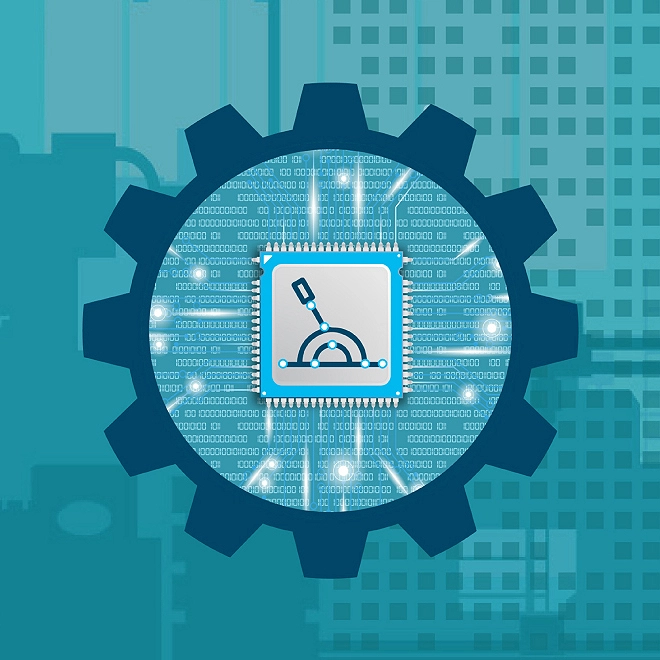Uncertainty and innovation at speed
How digital maturity can boost the ability to innovate
To thrive in an increasingly uncertain world, organizations need to be able to innovate quickly, not only now but after this crisis subsides. Those that are more digitally mature may have an edge.
THE COVID-19 pandemic has spurred many organizations to innovate in order to survive. While the acute uncertainty surrounding the pandemic will eventually recede, the decades-long trend of growing uncertainty is likely to continue. To thrive in this world, organizations need to be able to innovate quickly, not only now but after this crisis subsides. Those that are more digitally mature may have an edge.
Signals
- Because of the COVID-19 pandemic, uncertainty peaked during the first quarter of 2020, but it has been increasing for 30 years.
- Corporate executives mentioned innovation in half of earnings calls that took place during the early months of the pandemic.
- Companies in many industries innovated rapidly in the weeks after the World Health Organization declared a global pandemic.
- Global spending on digital transformation is projected to grow by 10.4% in 2020 to US$1.3 trillion.
Peak uncertainty
The COVID-19 pandemic has generated enormous uncertainty—for individuals, organizations, and governments. It is still not well understood how the disease spreads, why it affects some worse than others, and how best to treat it. And no one knows when a vaccine will be available or how effective it will be. Government responses to the pandemic have varied widely within and among countries, and from month to month as well, creating still more uncertainty for individuals and businesses.
Though uncertainty has crashed like a wave on the shores of society, the tide of uncertainty has been rising for decades. Researchers at the International Monetary Fund and Stanford University figure that uncertainty has been increasing for more than 30 years, especially over the last 10. They measure uncertainty by analyzing country reports published by the Economist Intelligence Unit. Their uncertainty index is based on the frequency with which the word uncertain or its variants appear as a percentage of the overall number of words in the text (figure 1).1 By this measure, the pandemic caused a spike in uncertainty but hasn’t changed the direction of the trend.

Economic policy specifically has become increasingly more uncertain in the United States and globally since the mid-2000s, according to another analysis performed by researchers at Northwestern University, Stanford University, and the University of Chicago.2 The analysis calculates an index based on newspaper coverage of policy-related economic uncertainty, the number of federal tax code provisions set to expire in the future, and disagreement among economic forecasters. The researchers found that since 2008, uncertainty about economic policy has averaged about twice the level of the previous 23 years. They also discovered that an increase in economic policy uncertainty as measured by their index foreshadows a decline in economic growth and employment in the following months.3 This is likely because uncertainty undermines confidence, and consumer confidence is an important driver of economic activity, especially in the United States.4
Uncertainty calls for innovation
Well-run organizations analyze and plan. When uncertainty is high, scenario planning can help organizations envision and prepare for a range of possible futures. Only about half of companies use scenario planning to help future-proof their strategies, though, according to a recent Deloitte survey of chief strategy officers.5 And when the future happens, it often differs from what was originally envisioned. Faced with unexpected events, organizations need to innovate. Just as important, they need to be able to innovate quickly, now and in the future.
In the pandemic’s early months, corporate executives talked a lot about innovation. In fact, they mentioned innovation in half of earnings calls that took place during those months.6 But executives talking about innovation is hardly new—about as many companies mentioned innovation on their earnings calls during the same period the prior year (figure 2).

What was new during this period was the focus of the companies’ innovation efforts. Our analysis of the earnings calls surfaced topics that were new in 2020 or more common than the prior year. Topics varied by industry but tended to have clear connections to the circumstances of the pandemic. For instance, when discussing innovation:
- Consumer-facing companies mentioned e-commerce more often, a reflection of the boost online commerce has gotten as people are social distancing.
- Companies in energy, resources, and industrials—an industry that has suffered a significant drop in stock market value—more often mentioned their balance sheets and supply chain.7
- Financial services and insurance companies mentioned risk management more often.
- Life sciences and health care companies more often brought up supply chain challenges as well as a variety of COVID-specific health care activities.
Rapid innovation in a crisis
The COVID-19 pandemic not only shifted the focus of corporate innovation—it triggered a burst of speed. As the pandemic began to unfold, we saw many examples of rapid innovation. For instance:
- A passenger airline shifted to cargo-only flights as passenger demand collapsed.
- A hotel chain offered workspaces at day rates to professionals unable to work from their offices.
- A movie studio released a new film directly to its streaming service, bypassing shuttered theaters.
- A retailer converted some of its sites into “dark stores” that served customers for pickup only.
- A mobile car cleaning and disinfection service scrapped a two-year national rollout plan and went national in two weeks instead.
- A pharmacy chain and a logistics provider announced that they would begin delivering prescription medicine to vulnerable residents of a retirement community by drone.
Most of these moves occurred just a few weeks after the World Health Organization declared the COVID-19 crisis a pandemic.
Perpetual crisis or business as usual?
While the current pandemic emergency will eventually subside, there is little sign that the future will be any more stable or predictable. As uncertainty continues to rise and the unexpected becomes more common, organizations may not always have the luxury to conduct extensive analysis before acting. Indeed, high uncertainty and rapid change tend to reduce the relevance of the data that companies may have traditionally used for planning. They may need to place bets on multiple possible futures. Above all, they will need a capacity for rapid innovation—every day, not just in a crisis.
How to innovate faster
Companies executed the rapid innovations described above by repurposing existing knowledge, resources, and technology. A recent article by three professors of strategic management and innovation described other examples of how repurposing during the crisis enabled rapid innovation.8 These include pharma companies repositioning, or repurposing, existing drugs for new conditions such as COVID-19; cosmetics and whiskey distilleries producing hand sanitizer; and various manufacturers shifting production capacity to ventilators or personal protective equipment such as face shields and masks. The authors—Georg von Krogh, Burcu Kucukkeles, and Shiko M. Ben-Menahem—suggest that organizations in all industries may be able to use repurposing to achieve ultrafast innovation to develop new solutions to our current and future challenges.
Repurposing is just one way of accelerating innovation. The extensive literature on innovation describes a variety of management practices that influence the pace of innovation in organizations. These often center on leadership, strategy, staffing, or process.9
Some innovation thinkers take inspiration from venture capital. Venture capital firms tend to tie funding to the achievement of milestones that reduce investment risk, such as proving technical feasibility or product-market fit, rather than to the calendar.10 This approach instills a sense of urgency in startup companies: Their very survival may depend on achieving a funding milestone. A crisis such as the COVID-19 pandemic can produce a sense of urgency in even large organizations. But banking on effective innovation in response to a crisis is not a robust strategy.
Digital transformation and fast innovation
Making effective use of technologies such as cloud computing, data analytics, and artificial intelligence, say von Krogh, Kucukkeles, and Ben-Menahem, is among the key principles of repurposing that can support ultrafast innovation. It is also among the digital pivots a company needs to make on the journey to becoming a digital enterprise, according to a 2019 Deloitte study.11 Each of the digital pivots can play a role in accelerating innovation. (See sidebar, “The digital pivots and their link to innovation.”12) The more broadly and deeply companies apply the digital pivots, the more digitally mature they tend to be. And the more digitally mature they are, the more successful they tend to be at driving innovation, according to another Deloitte study.13
The digital pivots and their link to innovation
Flexible, secure infrastructure involves leveraging cloud computing for scalability, agility, and cybersecurity to protect data, applications, and infrastructure—and to lower the risk of innovation.
Data mastery means using data and analytics to generate insights that can enhance efficiency and effectiveness, guide product development, and support new business models.
Digitally savvy, open talent networks involve securing flexible access to the talent and skills necessary to evolve and grow a digital business.
Ecosystem engagement involves working with business partners to gain access to resources such as intellectual property, technology, or talent that can help accelerate innovation.
Intelligent workflows mean leveraging automation to increase efficiency and effectiveness and free up resources to focus on higher-value tasks such as creating new products.
Unified customer experience means delivering a superior customer experience built on deep data-driven knowledge of the customer—a focus on many recent digital transformation initiatives accelerated by the pandemic.
Business model adaptability is about expanding the business models and revenue streams that can help a company adapt and thrive in changing conditions.
The pandemic has highlighted how critical agility and rapid innovation can be. We believe this is one reason why corporate investment in digital transformation remains strong. It is “one of the few bright spots in a year characterized by dramatic reductions in overall technology spending,” according to technology market analyst IDC, which recently projected that global spending on digital transformation technologies and services would grow 10.4% in 2020 to US$1.3 trillion.14 Companies seeking to develop their capacity to innovate quickly are continuing to invest in digital transformation.
Innovation in an era of uncertainty
At a time of rising uncertainty, an ability to innovate rapidly has never been more important. Innovation is complex and many factors influence an organization’s innovation ability. Digital maturity is one of those factors—and an increasingly key one. Some of the most innovative companies on the planet were born digital. For the rest, a concerted effort to become digital can help meet the growing need to innovate at speed.
Deloitte Cloud Consulting Services
Cloud is more than a place, a journey, or a technology. It's an opportunity to reimagine everything. It is the power to transform. It is a catalyst for continuous reinvention—and the pathway to help organizations confidently discover their possible and make it actual. We enable enterprise transformation through innovative applications of cloud. Combining business acumen, integrated business and technology services, and a people-first approach, we help businesses discover and activate their possible. Our full spectrum of capabilities can support your business throughout your journey to the cloud—and beyond.



